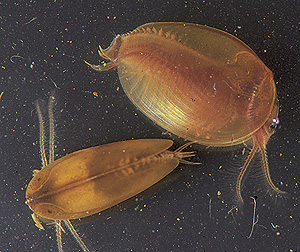
THE XERCES SOCIETY FOR INVERTEBRATE CONSERVATION Aquatic Invertebrates in Pacific Northwest Freshwater Wetlands |
| Identify taxa |
  |
|
Conchostraca (clam shrimp) |
Clam shrimp are found in exclusively freshwater, seasonal wetlands. The adults mate before the wetland dries up, then lay their cysts in the mud. The cysts are able to withstand the dry summer buried in the mud. When the wetlands fill with water again, the cysts rehydrate and hatch into clam shrimp larvae. This is a characteristic of many Branchiopods. Conchostracans are mostly benthic, digging through mud for macro-invertebrates, algae, and other plankton. |
Size:
medium to large Identifying feature(s): bivalve carapace which encloses the entire body, head, and appendages Habitat: freshwater lakes, ponds and temporary pools Tolerance to pollutants: |
 |
|
© 2007 Xerces Society
Contact info@xerces.org